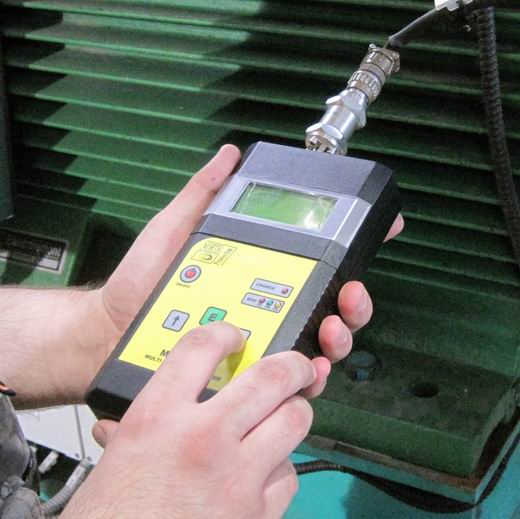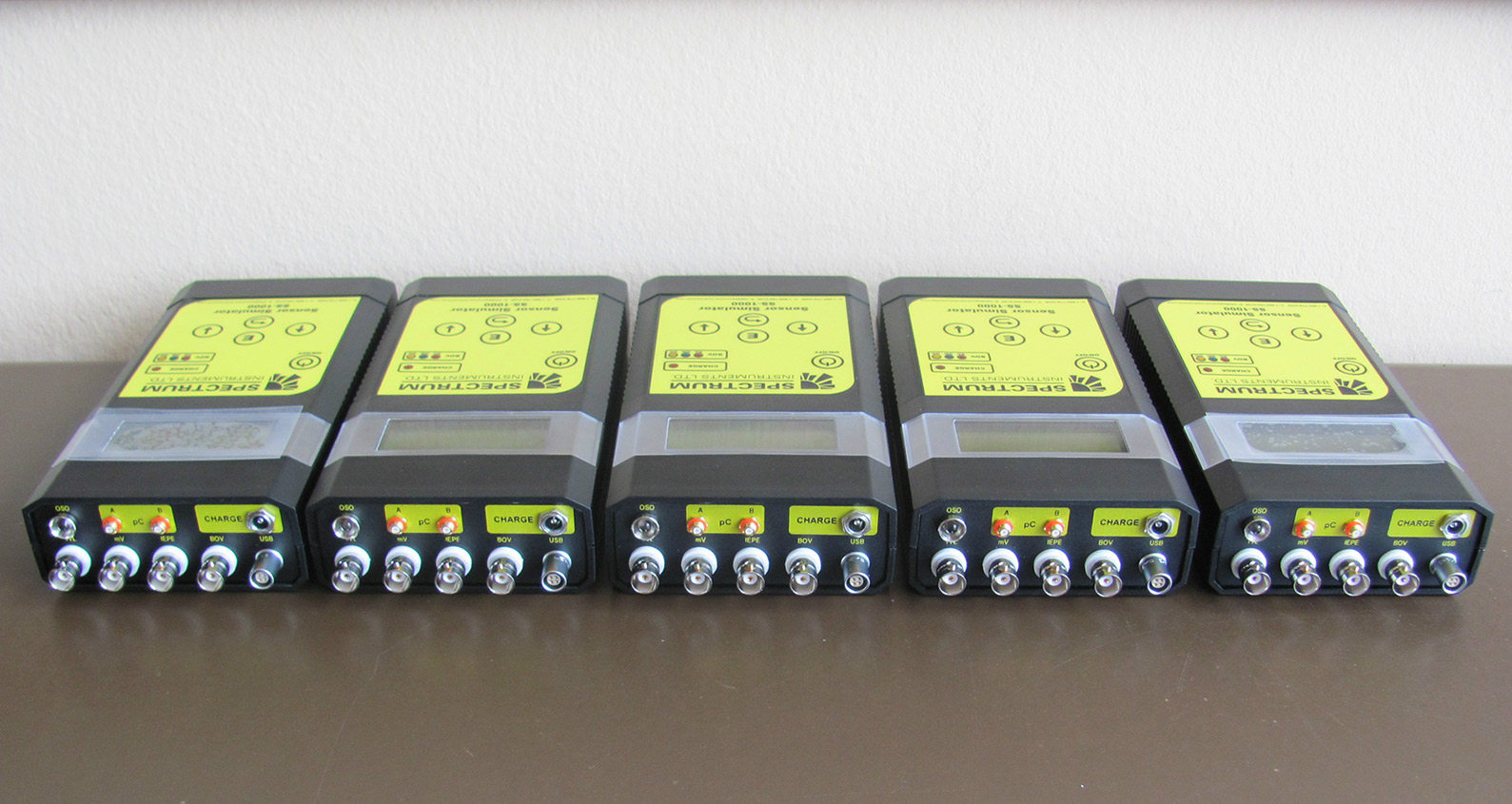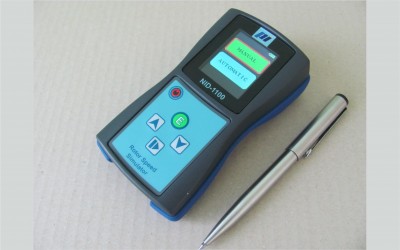MSC-1015 Multi Signal Calibrator

MSC-1015 is a battery operated instrument that is used to electronically simulate variety of outputs from various types of sensors.
MSC-1015 uses a menu-driven 4×16 character LCD display to establish the appropriate settings. Key panel contains five sealed switches marked with arrows, E (enter), Back and ON/OFF.
Power is supplied from 4 AA rechargeable, internally mounted Ni-MH batteries which can be recharged with a regulated 9Vdc source.
Connection to PC is established over the front mounted LEMO connector. PC mode will be automatically started after inserting proper cable into device.
Output signal is user selectable from: single-ended voltage (mV), single-ended charge (pC), differential charge (pC), current-sinking IEPE (ICP®), loop powered current source (mA), tachometer (TTL), flow (TTL), OSO® (Optical Speed Output) and BOV (Bias Output Voltage). Frequency range is 1Hz to 10kHz; RMS output voltage is from 10mV to 10V or 10pC to 10.000pC. Outputs can be provided in acceleration, velocity, displacement, voltage or charge.
Suitable for inspecting measurement lines according to ISO 10816 standards. Device is especially designed for Condition Monitoring Systems (CMS) and/or Vibration Monitoring Systems (VMS) that are independent or connect to SCADA Systems.
Application note
Suitable for inspecting measurement lines according to ISO 10816 standards. Device is especially designed for Condition Monitoring Systems (CMS) and/or Vibration Monitoring Systems (VMS) that are independent or connect to SCADA Systems.
MSS-1010 Multi-Sensor Simulator

MSS – 1010 is a battery operated instrument that is used to electronically simulate variety of outputs from various types of accelerometers.
MSS-1010 uses a menu-driven 4×16 character LCD display to establish the appropriate settings. Key panel contain five sealed switches marked with arrows, E (enter), Back and ON/OFF.
Power is supplied from 4 AA rechargeable Ni-MH batteries internally mounted which can be recharged with a regulated 9Vdc source.
Connection to PC is established over the front mounted LEMO connector. PC mod will be automatically started after inserting proper cable into device. Output signal is user selectable from: single-ended napon (mV), single-ended ®charge (pC), differental charge (pC), current-sinking IEPE (ICP), tachometer (TTL), ®flow (TTL), OSO (Optical Speed Output) and BOV (Bias Output Voltage).
Frequency range is 1Hz to 1kHz; output voltage RMS is from 10mV to 10V or 10pC to 10.000pC.
Outputs can be provided in acceleration, velocity, displacement, voltage or charge.
Application note
Suitable for inspecting measurement lines according to ISO 10816 standards. Device is especially designed for Condition
Monitoring Systems (CMS) and/or Vibration Monitoring Systems (VMS) that connect to SCADA Systems.
PC-100 Proximity Checker
Proximity Checker PC-100 is a battery operated easy to use instrument that is used to check sensor GAP and indicate it on LED bar integrated on front panel. There is also a LCD screen for displaying GAP voltage for better accuracy. PC-100 also can be used to simulate any current sensor with constant current output.
Power is supplied from one 9V alkaline internally mounted battery. There is also a LED indication of low battery.
Working mode can be selected by side switch mounted on left side. There is also a visual identification of selected mode placed on the front panel. In the middle position device is off.
In GAP TEST mode, PC-100 is measuring a GAP voltage on proximity sensor. Measured voltage is displayed on LCD screen and on LED diodes which indicated position of proximity sensor. This system enables easy mounting proximity sensor with simple adjustment procedure over LED bar. It is especially designed for fast check of proximity probes used in monitoring system. It also helps operator to setup proximity probe in optimal position and/or to get information about position of probe in front of the shaft.
In CURRENT SOURCE mode, instrument produce fixed current of 12mA. It is designed to get external 24V on this input and it generate fixed current trough integrated current loop.
SC-100 Sensor Checker
Sensor Checker SC-100 is a battery operated easy to use instrument that is used to check sensor condition by measuring bias voltage and to electronically simulate IEPE sensor output from accelerometers.
Power is supplied from one 9V alkaline internally mounted battery. There is also a LED indication of low battery.
Working mode can be selected by side switch mounted on left side. There is also a visual identification of selected mode placed on the front panel. In the middle position device is off.
In BOV TEST mode user can read measured bias voltage on the screen and sensor status on the LED diodes on the front panel. There are predefines sensor status which are depending from the bias voltage and they are: short circuit, sensor ok and open circuit. For short circuit, measured bias voltage is below 7V. For open circuit measured bias voltage is more than 15V. For sensor ok, measured bias voltage is between 7V and 15V. If the customer want different voltage levels, changes are possible free of charge before shipment.
In SIGNAL GENERATOR mode, instrument produce fixed frequency sinusoidal signal to simulate accelerometer or velocity meter output.
Parameters for checking (for sensor sensitivity 100mV/g)
NID-1100 Rotor Speed Simulator

NID-1100 Rotor Speed Simulator is a battery operated, handheld instrument which is used to electronically simulate outputs from various types of RPM sensors and transmitters in the range from 1.0 RPM to 60,000 RPM.
NID-1100 uses a menu-driven, 1.8″ TFT display (160×128 pixel, 18-bit colors) to establish appropriate settings. The key panel contains five sealed switches: Up Arrow, Down Arrow, E (Enter), Run/Stop and On/Off. The operating modes are: Manual and Automatic.
In Manual mode, the user can select the desired RPM value and the type of Output. Using Start/Stop key, the user can Start or Stop the output generation. During the generation of RPM output, the user can continually (On-line) increase or decrease the RPM value using Up or Down arrow.
In Automatic Mode, the user can select the nominal RPM, desired acceleration time (for RPM from zero to nominal), steady state time for nominal RPM and deceleration time (for RPM from nominal to zero), in range from 1.0 sec to 999.0 sec. Using Start/Stop key, the user can Start or Stop the programed output generation.
The user can select the Output signal from the following: RPM Tachometer Output (TTL Level), RPM Proximity Probe Output (powered by +24VDC), RPM Proximity Probe Output (powered by -24VDC), RPM OSO® Output.
Electric connection with DUT (Device Under Test) is established over the front mounted LEMO (ODU) Connector. Optical connection with DUT is established over the OSO (Optical Speed Output) front mounted LED.
NID-1003 TEDS Interface Kit
NID-1003 TEDS Interface Kit is a PC based TEDS Interface Kit. It can be used to read or write TEDS information in supported TEDS sensors. Software cover two versions of IEEE 1451.4 standard for smart transducers interface. It is designed to read/write TEDS information using the mixed mode communication protocol for versions 0.9 and version 1.0.
Interface Kit supports all standard Templates according to the IEEE P1451.4 (Version 0.9) and IEEE 1451.4 (Version 1.0). Non-standard Templates can be easily added upon the customer request.
TEDS Interface Kit is Plug & Play, USB powered from PC. PC software is easy to use, with an upgrade possibility. The sensor information can be also stored to the file. Standard interface kit includes: hardware and software with two Templates upon the customer request.



